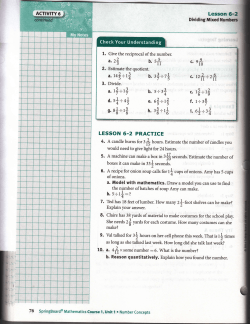
Parents’ Cough & Cold Kit for Children Winter/Spring 2008 By Andrew Weil, M.D.
Parents’ Cough & Cold Kit for Children Winter/Spring 2008 By Andrew Weil, M.D. Dear Parents, You may be aware that manufacturers have voluntarily recalled several children’s common over-the-counter cough and cold medications. This follows a recent public health advisory by the U.S. Food and Drug Administration (FDA), which stated that the remedies should not be used in children younger than two years of age. The FDA is still considering advisory action for children ages two to eleven. I applaud the FDA's action. Physicians have long been aware that cough syrups provide little, if any, benefit and could be dangerous. In this booklet So with many over-the-counter medications no longer available, you From the Medicine Cabinet may be concerned about what to do when your child comes down with Herbal Remedies/ Vitamin Supplements a cold. With the help of some of my most trusted and respected Food as Medicine of Pediatricians, I’ve put together this booklet describing safe, natural Tonic Soup Recipe ways for you to ease symptoms when your child comes down with Prevention Is the Best Treatment a cold. colleagues, as well as recommendations from the American Academy Sincerely, Andrew Weil, M.D. With many over-the-counter cold remedies pulled from the shelves, concerned parents are asking, “What can we do now?” While there is no cure for the common cold, there are several ways to make your young children more comfortable while the virus runs its course. Some of the following recommendations are adapted from those published by the American Academy of Pediatricians. See more at: http://www.aap.org/publiced/BR_Infections.htm Make sure your child drinks plenty of fluids to prevent dehydration. From the Medicine Cabinet To relieve a stuffy nose, use saline nose drops. Ask your pediatrician which ones he or she recommends. Never use over-the-counter nose drops that contain any medication. Clear a baby’s nose with a suction bulb. Squeeze the bulb, gently put the rubber tip into the baby’s nostril, and slowly release the bulb. This works best for babies younger than six months old. Use a cool-mist humidifier in the child’s room to moisten the air and help clear the child’s nasal passages. Clean the humidifier often. I recommend using distilled water, which has less potential to spread contaminants through the air and makes maintenance easier. To relieve fever, give acetaminophen or ibuprofen. Ask your pediatrician for the correct dosage for your child’s age and weight. Don’t give aspirin, as it has been associated with Reye’s Syndrome, a potentially fatal disorder that affects the liver and brain. Make sure your child drinks plenty of fluids to prevent dehydration. If the virus does not go away, or seems to get worse, call your pediatrician. Herbal Remedies/Vitamin Supplements Give echinacea and zinc lozenges if your children are old enough to suck them without swallowing or chewing them. But some children may not like the way they taste, and they can cause nausea. Follow package directions. At first sign of a cold, give extra vitamin C: 125 mg three times a day for children who weigh 20-29 pounds 250 mg three times a day for those who weigh 30- 59 pounds 500 mg three times a day for those who weigh more than 60 pounds Plain ascorbic acid is fine. There is no advantage to time released products. You can also try effervescent or powdered forms of vitamin C, which can be made into pleasant-tasting drinks. Avoid products containing artificial colors or sweeteners. Keep in mind that not all coughs are bad. Coughing is a natural way to bring up mucus that would otherwise compromise breathing passages. This kind of cough should be allowed to run its course as long as it’s clearing things out. Food as Medicine At the first sign of a cold, have the child eat a minced clove of raw garlic. Give ginger-root tea. Here’s a powerful one to try: Grate a one-inch piece of peeled gingerroot. Put it in a pot with two cups of cold water, bring to the boil, lower heat, and simmer five minutes. Add one half teaspoon cayenne pepper (or more or less to taste) and let simmer one minute more. Remove from heat. Add two tablespoons of fresh lemon juice, honey to taste, and one or two cloves of mashed garlic. Cool slightly and strain if desired. Get under warm covers and let the child drink as much as he or she wants! Prepare foods that include immune boosting Asian mushrooms such as reishi and maitake Serve soup. Chicken soup for colds is not a myth. University of Nebraska researchers exposed neutrophils (the white blood cells that fight infections but also cause inflammation) to diluted chicken broth. The liquid slowed the movement of the cells, suggesting that in the body, chicken soup can do the same thing, possibly relieving symptoms. Fish soup is revered as a cold-fighter in various cultures—and some physicians sanction hot and sour soup from Chinese restaurants. Chicken soup for colds is not a myth. Dr. Weil’s Tonic Soup A recipe from my book “Eight Weeks to Optimum Health” may also help. Here it is: Tonic Soup 8 cups vegetable stock 1 tablespoon olive oil 1 onion, diced 4-8 cloves garlic, minced One 1-inch piece of fresh gingerroot, peeled and finely chopped 1 cup sliced carrots 1 slice astragalus root 1 cup shiitake mushrooms (fresh or reconstituted), sliced 1 cup broccoli florets 1. Bring the vegetable broth to a boil in a large pot. 2. Meanwhile, heat the olive oil in a skillet and add the onion, garlic and ginger. Sauté over low heat until soft and aromatic. 3. Add contents of skillet to broth along with carrots, astragalus root, and shiitake mushrooms. 4. Simmer, covered, 1 hour. 5. Add the broccoli flowerets in the last 5 minutes, and remove astragalus before serving. Serves 8 Prevention Is the Best Treatment Remember that the best “treatment” for a cold is prevention. Make sure your children wash their hands regularly and avoid direct or indirect contact with people who have colds or fevers. As a preventive measure during the colds and flu season, take astragalus supplements, which are available at health food stores. The usual dose is the same for children or adults: 500 mg one-to-two times a day, unless the product’s package directs otherwise. For more information visit www.drweil.com
© Copyright 2025





















